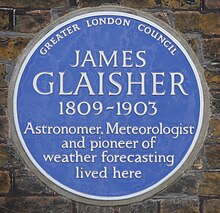James Glaisher
Between 1862 and 1866, usually with Henry Tracey Coxwell as his co-pilot, Glaisher made numerous ascents to measure the temperature and humidity of the atmosphere at the greatest altitudes attainable at that time.According to the Smithsonian Institution, Glaisher "brought along delicate instruments to measure the temperature, barometric pressure and chemical composition of the air.[12] In 1871, Glaisher arranged for the publication of his book about the balloon flights, Travels in the Air, a collection of reports from his experiments.To ensure that numerous members of the general public would learn from his experiences, he included "detailed drawings and maps, colorful accounts of his adventures and vivid descriptions of his precise observations", according to one report.[13] A report in The Daily Telegraph quotes Keith Moore, Head of Library at the Royal Society as saying: "It’s a great shame that Henry isn’t portrayed because he performed very well and saved the life of a leading scientist".


James Whitbread Lee GlaisherRotherhitheCroydonCecilia Louisa BelvilleMeteorologymeteorologistaeronautastronomerCambridge ObservatoryRoyal Observatory, Greenwichdew pointhumidityFellow of the Royal SocietyMeteorological SocietyRoyal Photographic SocietyRoyal Microscopical SocietyHenry Tracey CoxwellBlackheathblue plaqueSmithsonian InstitutionAmerican Philosophical SocietycraterThe AeronautsFelicity JonesEddie Redmaynegas balloonHenry CoxwellThe Daily TelegraphRoyal SocietyWayback MachineOxford Dictionary of National BiographyChapman, AllanThe Antiquarian AstronomerSociety for the History of AstronomyBibcodeQuarterly Journal of the Royal Astronomical SocietyRoyal Astronomical SocietyInternational Astronomical UnionDeadline HollywoodEncyclopædia BritannicaLibriVoxCharles GreenArthur BersonReinhard Süring